The future of tyres: the latest tech and eco tyres
Tyre technology is moving fast, and we look at the top 10 tyre revolutions you need to know about
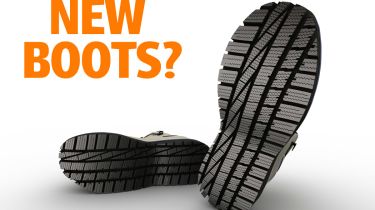
You may not think so, but tyre technology is ever changing and moving on at speed, as new production processes are frequently introduced to make drivers’ lives safer.
• Winter tyres test: 2014 reviews
Run-flat tyres have been the big news in recent years. These have brought big safety benefits, as they let motorists carry on driving even when the tyre is punctured, so there’s no need to risk your life by trying to change a wheel at the roadside. Plus, they’ve helped to reduce CO2 emissions and rein in fuel consumption, as cars fitted with run-flats no longer need to haul around a heavy spare wheel.
• Wheel and tyre product reviews
But run-flat technology is just the beginning. We’ve rounded up 10 of the best tyre technologies that you can expect to be using on a daily basis in years to come.
Tall and narrow
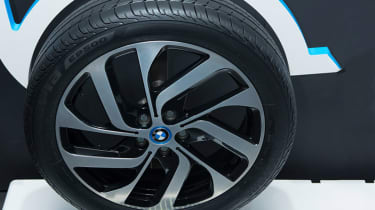
BridgestoneExpect to see it: Now
Even though the new all-electric BMW i3 is a compact city car, its wheels are a whopping 19 inches in diameter. But this size wasn’t just chosen to make concept versions look sporty; production models get these wheels, complete with far thinner tyres, featuring a skinny profile of 155/70 R19. They help to save energy – not only do the wheels cover a greater distance with a greater diameter, but as they’re so slim, they cut through the air more efficiently, because they’re more aerodynamic – which means the car isn’t held back by drag. Bridgestone is the official supplier to BMW for the i3’s tyres.
Chip-in-tyre
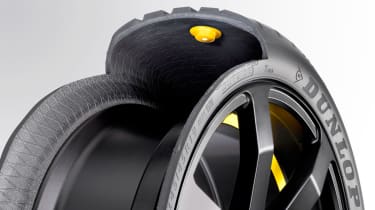
Goodyear-DunlopExpect to see it: 2016
By inserting a chip into the rubber, Goodyear-Dunlop claims that tyres will be able to communicate with the car – talking to the electronic control unit and anti-lock brakes, for example – to adapt to the road conditions. The batteryless chip tells the car what kind of tyre is fitted, and relays air pressure and temperature to achieve optimum braking and cornering performance.
Individual readings of tyre status will be displayed. The tech is set to debut on new cars first, before being available on the aftermarket – and the chip, fitted to the centre of a tyre’s tread, is claimed to be light enough not to disturb the balance of a wheel.
Twin Air Chamber
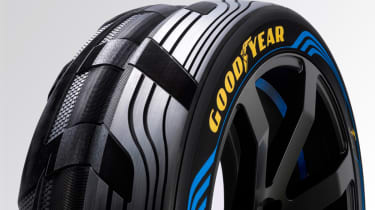
Goodyear-DunlopExpect to see it: 10+ years
This concept, intended for SUVs, splits the tyre’s air chamber into two. The idea is that if one pocket punctures, drivers can continue their journey on the other at a reduced speed. The two chambers sit side-by-side, and Goodyear-Dunlop claims a benefit of the design is that the tyre has a smaller contact area with the road, with the two chambers separated by a wide groove. Plus, the maker says this groove helps to bring about a reduction in the tyre’s weight, and in turn rolling resistance and fuel consumption. Despite the reduced contact area, the new design is also said to be as safe as any other tyre.
Self-inflating tyres
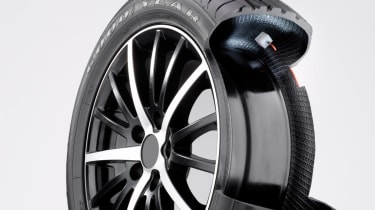
Goodyear-DunlopExpect to see it: 5-8 years
Another Goodyear-Dunlop innovation called Air Maintenance Technology (or AMT) packs an electronic part into a tyre that regulates air pressure. It detects how much air is in a tyre and tops it up automatically if necessary. This would effectively eliminate the need for drivers to pump up their own tyres – and as research has shown that running tyres at just a few psi under their recommended pressures can have a serious impact on fuel efficiency, this could be a real breakthrough. The concept was first earmarked for commercial vehicles, but AMT is likely to be extended to passenger cars.
Fossil-free tyre
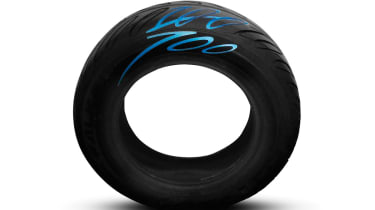
FalkenExpect to see it: 2015
Falken's clever new Enasave 100 tyre replaces synthetic rubber with natural alternatives, and conventional carbon black with biomass-derived carbon black. Normal tyres now use around 60 per cent synthetic material, and this project has been in the pipeline for 13 years. Instead of using fossil resources for rubber antioxidants, the tyre is made by a unique process using plant oil instead of mineral oil, natural rubber and silica. As well as their obvious eco-friendly benefits, Enasave 100 tyres are claimed to wear better and deliver better fuel efficiency and wet grip performance.
All-in-one tyre and wheel
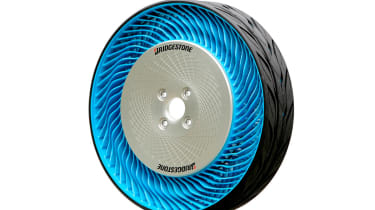
BridgestoneExpect to see it: 3-5 years
By ridding a tyre of air completely, manufacturers can remove the risk of drivers suffering a puncture. On a normal car, this would severely compromise comfort, although Bridgestone has this in mind for light, single-seater, electric-powered city cars. The construction of the tyre does factor in some level of comfort, as the wheel is spring-loaded all the way around with small spokes, and there is a shallow rubber coating. It’s also made of recyclable materials as Bridgestone hopes to be 100 per cent sustainable within 50 years. Still, the design is expected to wear slower and last longer than an air-filled tyre.
Soybean-made tyres

Goodyear-DunlopExpect to see it: 2015
Researchers at Goodyear-Dunlop’s US Innovation Centre have found the tread of tyres produced using soybean oil lasts up to 10 per cent longer than regular versions. And if all tyres were made this way, the drain on oil-based resources could be cut drastically. This is part of the company’s move to make tyre manufacturing sustainable. Compounds made with soybean oils have been found to form a better bond with the silica used to make tyres – this would increase plant efficiency, and help the company use less energy in its factories.
ContiSilent
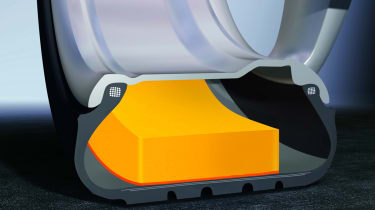
ContinentalExpect to see it: Now
Continental claims its ContiSilent tyres can cut cabin noise by up to 9dB – and they’re made by simply applying a coating to the inside of the main tread area of the tyre after it’s made. They’re equipped to perform at the top level, as the only two sizes available at present are for the Audi RS6 and RS7 with ContiSportContact 5s – although the concept is expected to be extended to fit other cars. Yet Continental claims that braking, handling and wet grip performance aren’t affected with a set of ContiSilent tyres fitted.
Dandelion rubber

ContinentalExpect to see it: 5+ years
Continental's view of a sustainable future for tyre manufacture involves dandelion plants. The company is on the verge of developing this new mass production method that will introduce the weeds – optimised and cultivated for mass demand. Details are sketchy at the moment, with Conti not surprisingly playing its cards close to its chest. But this doesn’t only have the potential to reduce the brand’s carbon footprint by cutting its reliance on fossil materials; the dandelions can also be grown close to Conti’s factories, to save on the logistical strain of hauling around raw materials.
Natural oil-derived tyre
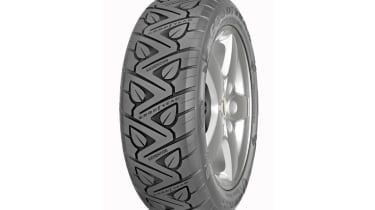
Goodyear-DunlopExpect to see it: 10+ years
Goodyear-Dunlop’s take on producing a natural oil-based tyre has been developed in conjunction with DuPont Industrial Biosciences, and is a key rubber ingredient called Biolsoprene. This can be used in the production of synthetic rubber – which in turn is an alternative for natural rubber – and other elastomers. The development of BioIsoprene will help reduce the tyre industry’s dependence on oil-derived products as Goodyear-Dunlop looks to drastically reduce its carbon footprint.
Find a car with the experts


